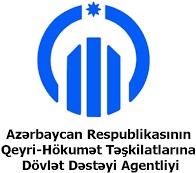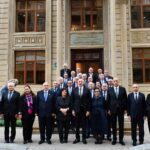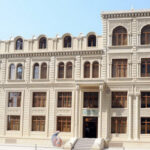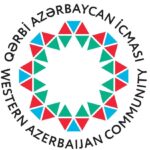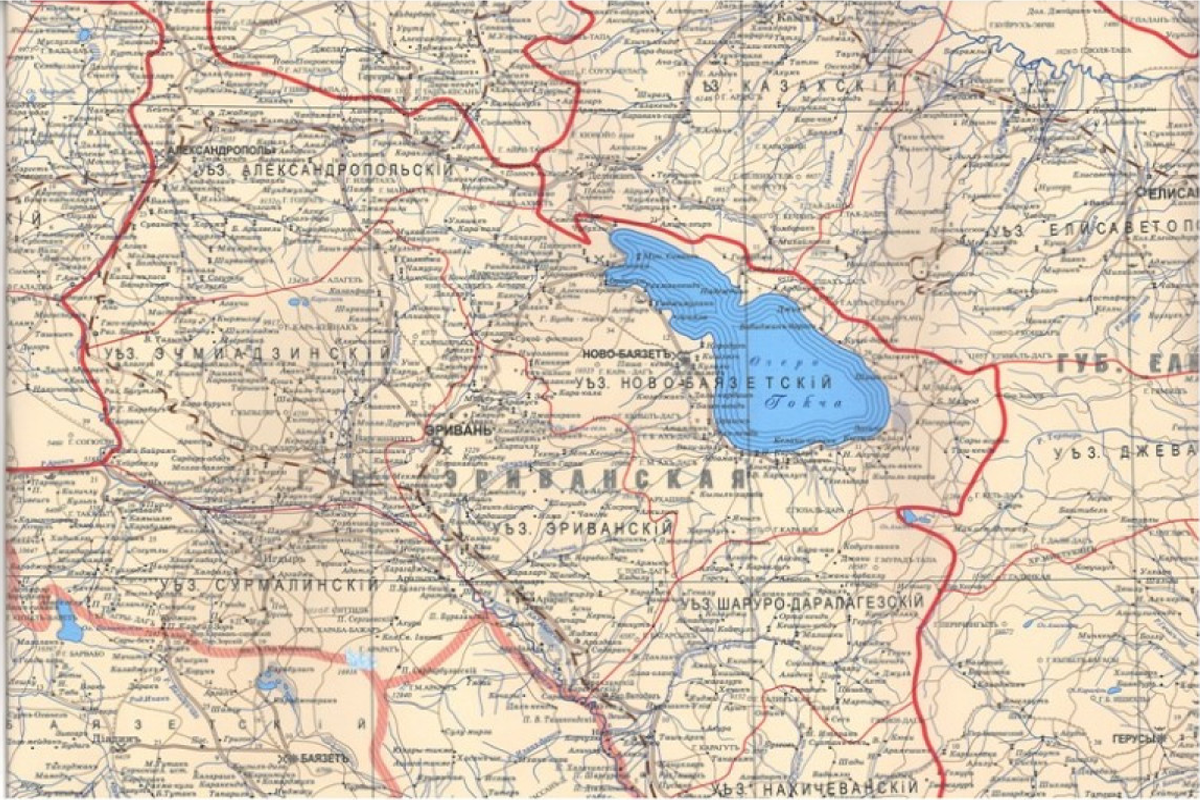(1827-1917)
1747-1827 – Iravan Khanate, the center of which is the city of Iravan in Azerbaijan. With the establishment of the Iravan Khanate, a large part of the lands of Western Azerbaijan became one of the independent states of the Khanate era of Azerbaijan. In the Russian Empire’s struggle for power in the South Caucasus at the beginning of the 19th century, the occupation of the Iravan Khanate and other territories included in the territory of Western Azerbaijan occupied one of the main places. During the war of 1804-1813, it was not possible to implement this plan. After a 13-year break, a new war began.
1. The occupation of Iravan and the first Armenianization measures.
(1827, October-1828, March)
1826-1828 – a new war between Russia and Iran. Its central issue was the war between the Russian Empire and the Iravan Khanate. So, precisely after the fall of the Iravan Khanate, Russian troops crossed Araz and entered the territory of South Azerbaijan.
1827, October 1 – capture of the city of Iravan by the Russian Empire during the Russo-Iranian War (1826-1828). Completion and abolition of the occupation of the Khanate. Establishment of Iravan province.
1827, October-1917, October – Western Azerbaijan within the Russian Empire. Like other Azerbaijani lands that were annexed to the Russian Empire in earlier times, its historical western territory also fell under the rule of the Christian state. The policy of Christianization and Armenianization of the Russian Empire here was a symmetrical violation of the rights of Azerbaijanis.
1827, October 6 – preparation of general rules for the administration of the Iravan province by I.F. Paskevich, the commander-in-chief of the Russian troops in the Caucasus. According to the rules, an Interim Administration is established to conduct the work on the civil part. A. I. Krasovsky is the chairman, and Bishop Nerses and A. Borodin, the temporary commandant of the Iravan fortress, are the members. [4, doc. 432, p. 480-481]
1828, February 10 – Russian-Iranian Turkmenchay Treaty. Officialization of the annexation of the Khanates of Nakhchivan and Iravan to the Russian Empire. [11, doc. 1794, p. 123-130] The division of Azerbaijani lands between Turkmenchay and Russia and Iran was completed. A colonial system was established in the territories that came under the control of the Russian Empire. One of its main indicators was the distribution of ethnic-national territories among artificially created administrative units. When the administrative-territorial division carried out by the Russian Empire in the South Caucasus stabilized to a certain extent, there were five governorates (Tbilisi, Iravan, Baku, Kutais and Yelizavetpol (Ganja). The lands of Azerbaijan were divided among four governorates (except Kutais). The colonial regime in the territory of Western Azerbaijan had certain characteristics Armenian historiography tries to create non-scientific concepts such as “Eastern Armenia” for the western lands of historical Azerbaijan, and “Western Armenia” or “Turkish Armenia” for the eastern Anatolian lands, “Eastern Armenia” tries to justify its progress within the Russian Empire [19 etc.]
1828-1831-According to the agreements of Turkmenchay and then Edirne (1829), mass transfer of Armenians to North Azerbaijan, including the territory of the former Iravan Khanate. According to the report of Colonel L. Lazarev (Lazaryan) to Paskevich on June 14, 1828, 3900 (52.3%) of the 7458 Armenian families transferred from Iran were settled in Iravan province. According to official statistical information, the number of Armenian families relocated in 1829-1831 was 6946 (35560 people). Of them, 366 families (1715 people) were located in the city of Iravan, respectively 4193 (21853 people) were located in 10 districts of Iravan. These figures for Iravan city and districts were 4559 families (65.6%). In fact, these numbers were much higher. The number of Armenian families transferred from the Ottoman Empire under the Treaty of Edirne was 14 thousand or more than 100 thousand people. Together with those transferred from Iran, the total number reached 145 thousand. [18, c. 32-33, 39] The Russian batalist artist Moshkov (Mashkov) described this event in his painting “The transfer of 40 thousand Armenians to the Russian borders by the personal order of Colonel Lazarev”.
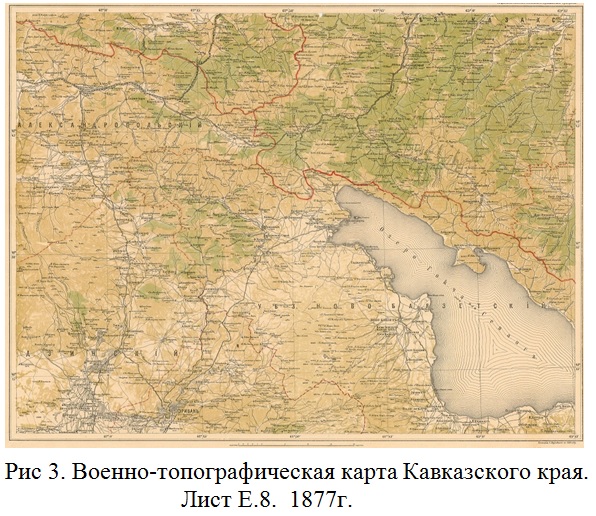
2. “Armenian province”: the policy of institutionalization of Armenians and its fall
(1828-1840s)
1828, March 21 – the creation of “Armenian province” on the basis of Iravan and Nakhchivan khanates of Azerbaijan by decree of Nicholas I (1825-1855). [11, doc. 1888, p. 272-273] A certain political line was formed in relation to the captured Azerbaijani khanates during the first period of Russian occupation. Khanates that resisted were abolished and turned into provinces. The khanate system was temporarily maintained in the khanates held by contract. In relation to the Khanates of Iravan and Nakhchivan, a sharper anti-Azerbaijani step is taken. “Armenian Province” is being organized on the historical lands of Azerbaijan without any basis. The matter does not end there, unlike other occupied territories of Azerbaijan, this province is included in the emperor’s title.
1829-1873 – Conducting camera images from the main sources on the population of the “Armenian Province”, and later, the Iravan district and governorate.
1829-1832 – I. Chopin (who was a relative of the famous composer) held a chamber painting in the “Armenian province”. It also provides information on the number and ethnic composition of Iravan’s population in the situation after the occupation of Iravanby Russia. Since these numbers play the role of the base for the next period, they should be specially mentioned. Number of Muslims: families 1807, men 3749, women 3582, total 7331 people. It should also be taken into account that a certain part of the Muslim population left the city during the occupation. Chopin divides Armenians into two groups: natives (in fact, they were those who came earlier) and newcomers. The number of “locals” was as follows: families 567, men 1220, women 1149, a total of 2369 people. Arrivals are divided into two places, Iran and Turkey. Arrivals from Iran: families 366, men 903, women 812, total 1715 people. Those who came from Turkey: 11 families, 25 men, 23 women, total 48 people. As can be seen from the figures, if the arrivals are not taken into account, the population of Iravan was 9,700 people, of which 75.58% were Muslims, and 24.42% were “local” Armenians. As a result of the transfer, the ethnic composition of the population of Iravan begins to change. Thus, the number of resettled Armenians (1763 people) was 18.17% of the existing population (9700 people). As a result, Muslims made up 63.95% of the total population (11,463 people), and Armenians made up 36.05%. [20, p.543-546] Despite the policy of the tsarist government, until 1918 it was not possible to turn the city of Iravan into either a political or an economic center of Armenians. These territories are not included in the concept of homeland of Armenians. Armenian politicians and capital mainly sought Baku and Tbilisi.
1833, February 27 – adoption of the coat of arms of the “Armenian province”. The analysis of the coats of arms of this province, and then of the Iravan district (1843) and governorate (1878) (in each case, Armenian and Christian attributes are given as the leading elements in the coats of arms) shows that Nicholas I stubbornly tried to achieve the Armenianization and Christianization of the Iravanregion, and his successors followed this policy.
1833, June 22 – tsar’s decree consisting of 16 articles entitled “On the administrative structure of the Armenian province, with the addition of the states of this administration”. According to the decree, a tax and duty collection department was established in Iravan. The province of Iravan, consisting of 10 districts, was divided into Iravan, Sharur, Sardarabad and Surmeli districts. Colonel Ehsan Khan and Major Shikhali Bey stayed as viceroys in Nakhchivan and Ordubad, etc. [12, doc. 6282, p. 374-375]
1836, March 11 – Adoption of the Statute on the Armenian-Gregorian Church. Important rights are granted to the Armenian Church by the tsarist government. It is no coincidence that this Statute refers to the Armenian Church of the Transcaucasia (This term reflects the geopolitics of the Russian Empire. The terms South Caucasus or Transcaucasia are also used. When talking about the reality of the time, that term is kept, and in the author’s commentary, the term South Caucasus is preferred.-K.S.) not as, but generally referred to as the Armenian-Gregorian Church, it meant the unification of Armenians around the world. According to the statute, 6 dioceses were defined within the borders of Russia. Among them were the dioceses of Iravan, Karabakh and Shirvan, covering the territories of Azerbaijan. [13, doc. 8970, с.194-209] The Armenian-Gregorian Church, using this Statute, has a strong position both politically and materially. Although an attempt was made by the tsarist government to weaken this position in 1903, it failed. In addition to the statute, the tsarist government tried to increase the influence of the Armenian-Gregorian Church by other means. Nicholas I met with the Armenian Catholicos during his visit to the Caucasus.
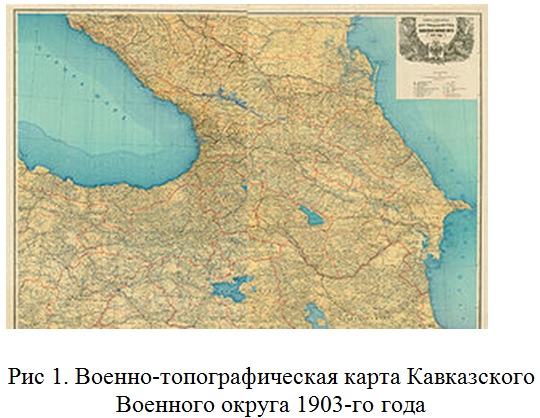
2. “Armenian province”: the policy of institutionalization of Armenians and its fall
(1828-1840s)
1828, March 21 – the creation of “Armenian province” on the basis of Iravan and Nakhchivan khanates of Azerbaijan by decree of Nicholas I (1825-1855). [11, doc. 1888, p. 272-273] A certain political line was formed in relation to the captured Azerbaijani khanates during the first period of Russian occupation. Khanates that resisted were abolished and turned into provinces. The khanate system was temporarily maintained in the khanates held by contract. In relation to the Khanates of Iravan and Nakhchivan, a sharper anti-Azerbaijani step is taken. “Armenian Province” is being organized on the historical lands of Azerbaijan without any basis. The matter does not end there, unlike other occupied territories of Azerbaijan, this province is included in the emperor’s title.
1829-1873 – Conducting camera images from the main sources on the population of the “Armenian Province”, and later, the Iravan district and governorate.
1829-1832 – I. Chopin (who was a relative of the famous composer) held a chamber painting in the “Armenian province”. It also provides information on the number and ethnic composition of Iravan’s population in the situation after the occupation of Iravanby Russia. Since these numbers play the role of the base for the next period, they should be specially mentioned. Number of Muslims: families 1807, men 3749, women 3582, total 7331 people. It should also be taken into account that a certain part of the Muslim population left the city during the occupation. Chopin divides Armenians into two groups: natives (in fact, they were those who came earlier) and newcomers. The number of “locals” was as follows: families 567, men 1220, women 1149, a total of 2369 people. Arrivals are divided into two places, Iran and Turkey. Arrivals from Iran: families 366, men 903, women 812, total 1715 people. Those who came from Turkey: 11 families, 25 men, 23 women, total 48 people. As can be seen from the figures, if the arrivals are not taken into account, the population of Iravan was 9,700 people, of which 75.58% were Muslims, and 24.42% were “local” Armenians. As a result of the transfer, the ethnic composition of the population of Iravan begins to change. Thus, the number of resettled Armenians (1763 people) was 18.17% of the existing population (9700 people). As a result, Muslims made up 63.95% of the total population (11,463 people), and Armenians made up 36.05%. [20, p.543-546] Despite the policy of the tsarist government, until 1918 it was not possible to turn the city of Iravan into either a political or an economic center of Armenians. These territories are not included in the concept of homeland of Armenians. Armenian politicians and capital mainly sought Baku and Tbilisi.
1833, February 27 – adoption of the coat of arms of the “Armenian province”. The analysis of the coats of arms of this province, and then of the Iravan district (1843) and governorate (1878) (in each case, Armenian and Christian attributes are given as the leading elements in the coats of arms) shows that Nicholas I stubbornly tried to achieve the Armenianization and Christianization of the Iravanregion, and his successors followed this policy.
1833, June 22 – tsar’s decree consisting of 16 articles entitled “On the administrative structure of the Armenian province, with the addition of the states of this administration”. According to the decree, a tax and duty collection department was established in Iravan. The province of Iravan, consisting of 10 districts, was divided into Iravan, Sharur, Sardarabad and Surmeli districts. Colonel Ehsan Khan and Major Shikhali Bey stayed as viceroys in Nakhchivan and Ordubad, etc. [12, doc. 6282, p. 374-375]
1836, March 11 – Adoption of the Statute on the Armenian-Gregorian Church. Important rights are granted to the Armenian Church by the tsarist government. It is no coincidence that this Statute refers to the Armenian Church of the Transcaucasia (This term reflects the geopolitics of the Russian Empire. The terms South Caucasus or Transcaucasia are also used. When talking about the reality of the time, that term is kept, and in the author’s commentary, the term South Caucasus is preferred.-K.S.) not as, but generally referred to as the Armenian-Gregorian Church, it meant the unification of Armenians around the world. According to the statute, 6 dioceses were defined within the borders of Russia. Among them were the dioceses of Iravan, Karabakh and Shirvan, covering the territories of Azerbaijan. [13, doc. 8970, с.194-209] The Armenian-Gregorian Church, using this Statute, has a strong position both politically and materially. Although an attempt was made by the tsarist government to weaken this position in 1903, it failed. In addition to the statute, the tsarist government tried to increase the influence of the Armenian-Gregorian Church by other means. Nicholas I met with the Armenian Catholicos during his visit to the Caucasus.
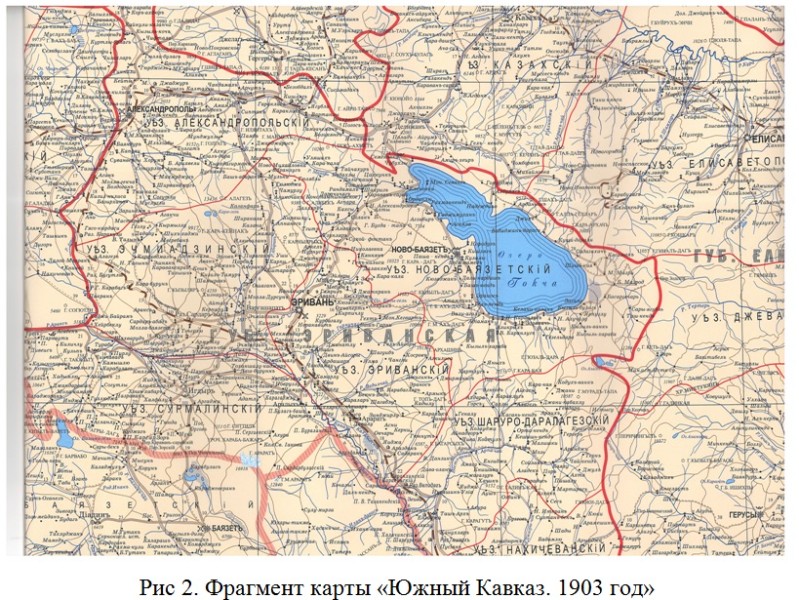
4. Iravan governorate
(1849-1917 years)
1849, June 9 – tsar’s decree on the creation of a governorate of the same name in Transcaucasia with Iravan as the center. According to the decree, 5 governorates are divided into five gubernias – Iravan (the city of Iravan uzed), Novo-Bayazet (the village of Kover was renamed Novo-Bayazet and given the status of the city of uezd), Nakhchivan, Ordubad, Alexandropol. The territorial-administrative division of the province was continued in 1867. According to the decree of December 9, the following districts are defined: Iravan, Alexandropol, Etchmiadzin, Novo-Bayazet, and Nakhchivan. In 1875, two more districts were created – Sharur-Darelayaz and Surmeli districts. Thus, the number of uezds is increased to seven. [16, dok.23303, с.311-312] According to the Caucasian calendar of 1917, the territory of Iravan governorate is 26210.11 sq. km was This figure for the Iravan uzed is 3,078.46; 3826.97 for Alexandropol; 3658.26 on Echmiadzin; 4658.72 in Novobayazet; 4451.11 in Nakhchivan; 2980.37 in Sharur-Darelayaz and 3556.21 sq. in Surmeli. km. organized. [8, department of Statistics, p. 218]
1850, January-1917, February – Iravan governorate during the tsar’s rule.
1853 – publication of the volume on the Iravan governorate from the series on the military-statistical review of the Russian Empire. [7]
1870, May 14 – Peasant reform. ²Transcaucasia governorates: Yelizavetpol, Baku, Iravan, and partly Tiflis governorates on the land structure of persons from high Muslim silk, as well as former state peasants living on the lands of Armenian owners². As the name of the statute suggests, the historical reality is distorted. The tsarist government purposefully applies the concept of ²Armenian princes², whereas there was no such concept in the legal documents before this period.
1877-1878 – Russian-Ottoman war. The Treaty of San Stefano (1878, February), and then the signing of the Treaty of Berlin (1878, July). [21, No. 54, p. 243-270] Annexation of Ardahan, Kars and Batum to Russia. The emergence of ²Armenian issue².
1879, October 1 – the commencement of Iravan city duma in accordance with the city charter of 1870. Iravan duma became one of the main anti-Azerbaijani centers of the city.
1881, November – opening of Iravan Teachers’ Seminary. On December 29, 2021, a decree was signed by the President of the Republic of Azerbaijan on the celebration of the 140th anniversary of the Seminary.
1882 – Creation of Iravan theater. On July 14, 2022, the President of the Republic of Azerbaijan signed a decree on the celebration of the 140th anniversary of the Iravan State Azerbaijan Drama Theater.
1884-1914 – Reports of the governor of Iravan. It was one of the main official documents for the governorate. [9]
1887 – Organization of the Social-Democratic Gnchak (Zang) party in Geneva. The name of the bell is adopted from A. I. Gertsen’s ²Kolokol². Andranik, one of the cruel enemies of Azerbaijan, was once a member of this party.
1890 – organization of Dashnaksut’s party in Tbilisi. At the end of the 19th and the beginning of the 20th century, the terms Armenian and Dashnak basically had the same meaning. He was an active organizer of every genocide against the people of Azerbaijan. He established a government in th
1906 – Iravan-Julfa railway line was commissioned.
1914-1916 – On the eve of the First World War, the population of Iravan was 29,366 people, of which 11,500 people (39.2%) were Azerbaijanis, and 15,531 people (52.8%) were Armenians. In 1916, the population of Iravan reached 51,286 people (+21,920 people) from 29,366 people in 1914. [1, p.228] Compared to 1897, it is clear that the demographic situation of Azerbaijanis in Iravan begins worsened at the beginning of the 20th century. During the war, the oppression of Azerbaijanis expanded by purposefully directing Armenian refugees to the city of Iravan.
1914, August – Russia enters the First World War. The expansion of the struggle of Armenians to create a state in the territory of the Ottoman Empire through Russia.
1914, September-November – the creation of Armenian volunteer units by the Russian Empire. He actively participated in the genocide against the Turks in Eastern Anatolia, and then against the Azerbaijanis in the Iravan region. In December 1917, it became the Armenian volunteer corps. The head of this corps, Foma Nazarbekov, was the commander-in-chief of the army of the Republic of Armenia in 1918-1920 with the rank of lieutenant general, first Armenian state, the First Republic (1918-1920), was created in the lands of Western Azerbaijan.
1897, January – the first general population census in the Russian Empire. According to the results of the Iravan governorate, there were 29,006 people in the city of Iravan. Among the population, there were 12,359 (42.69%) people whose mother tongue was Tatar (Azerbaijan.-K.S.), and 12,153 (41.89%) people who spoke Armenian. The ratio of Muslims and Christians (Armenian-Gregorian and Armenian-Catholics) was 12537 (43.22%) and 12516 (43.15%). [9, p. 2-3] Compared to the 1829-1832 cameral description, it appears that the population increased by 17,543 people (60.49%). There was a more serious change in the ethnic and religious composition of the population. The number of Armenians is almost equal to the number of Muslims.
1902, December 5 – the opening of the Alexandropol-Iravan railway line. The construction of this and subsequent railway lines increased the strategic importance of Irvan.
1903, June 12 – Tsar Nicholas II’s decree on the confiscation of the properties of the Armenian-Gregorian Church. Under the pressure of Armenian terror, the property confiscated by the decree of August 1, 1905, was returned. [17, doc. 23156, p. 778-779]
1905-1906 – During the ²Armenian-Muslim conflict², Armenians killed hundreds of Azerbaijanis in the Iravan province, including the city of Iravan, and expelled them from their historical lands. [2, pp. 31-42, etc.; 5, c. 591-600]
1917, February-October – during the Provisional Government of West Azerbaijan.
1917, March 9/22-November 15/28 – Special Transcaucasian Committee (Ozakom), the local authority of the Provisional Government in Transcaucasia. The chairman was V.A. Kharlamov (cadet). It included M. Y. Jafarov, M. I. Papachanov, K. G. Abashidze, and P. N. Pereverzyev. Soon after, P. N. Pereverzyev replaced A. I. Chhenkel.
1917, April 26/May 9 – Provisional government’s decision on “Turkish Armenia”. According to this decision, which consists of four articles, until the status of Turkey-Armenia is determined by the peace treaty, its territory occupied by the Russian army, in terms of civil administration, was removed from the administration of the Caucasian authorities, and at the same time, the administration of the authorities of the Caucasian front, and was subordinated to the Provisional Government, and the position of the High Commissioner of Turkey-Armenia was established. and so on. [3, p.356-357] Thus, the Provisional government applied the concept of “Turkey to Armenia” and focused on the territory of Turkey in order to bring Armenians closer to its side. Soviet Russia also continued this line. As it will become clear later, since the Ottoman Empire liberated those territories, the creation of the Armenian state will take place in the Transcaucasia, in the lands of Western Azerbaijan.
1917, end of September-beginning of October – establishment of the Armenian National Council. Its leader was A.V. Aharonyan (Dashnak). The National Council of Azerbaijan conducted negotiations about Iravan with this organization.
1917, October 25/November 7 – In the October Revolution in Russia, the Bolsheviks took power. The collapse of the Russian Empire. Separation of the Iravan governorate together with other Azerbaijani lands from the Russian Empire. Thus, despite the purposeful Armenianization of its historically formed administrative-territorial structure, ethno-confessional composition, political structure, and management system with the occupation of Western Azerbaijan by the Russian Empire and the colonial policy that continued systematically for 90 years, these lands, the leading population foundation existing there and it was not possible to change the fact that the culture belongs to Azerbaijanis. Western Azerbaijan, as a part of entire Azerbaijan, left the Russian Empire as a Turkish-Muslim land and entered the territory of the Transcaucasia government.
Short bibliography
1. Habib Rahimogu. Indelible names, incurable wounds. Baku, 1997
2. Ordubadi M.S. Bloody years. The history of the Armenian-Muslim conflict in the Caucasus in 1905-1906. Baku, 2007
3. Archive of the new history of Russia. Sessions of the Provisional Government. т.1, M., 2001
4. Acts of the Caucasian Archaeological Commission. t.7. Tiflis, 1878
5. Jabbarov F. Armenian extremism in the South Caucasus (second half of the 19th – early 20th centuries Baku, 2018
6. Berzhe A., Emperor Nicholas in the Caucasus in 1837 / / Russian antiquity. 1884, No. 8
7. Military statistical review of the Russian Empire. v. 16, part 6. Iravan province. SPb., 1853, 300 p.
8. Caucasian Dairy for 1917 Tiflis, 1916
9. Reports of the Iravan Governor. 1884-1914// Russian State Historical Archive. f.1284, op.223, file 123 and etc.
10. The first general census of the population of the Russian Empire in 1897 LXXI. Iravan province. SPb., 1905
11. Complete collection of laws of the Russian Empire. Sobr. Tue. St. Petersburg, 1830, vol. III
12. Complete collection of laws of the Russian Empire. Sobr. Tue, vol. VIII. SPb., 1834
13. Complete collection of laws of the Russian Empire. Sobr. Tue., Vol. XI, St. Petersburg, 1837
14. Complete collection of laws of the Russian Empire. Sobr. Tue. St. Petersburg, 1841, v. XV
15. Complete collection of laws of the Russian Empire. Sobr. Tue. St. Petersburg, 1847, v. XXI
17. Complete collection of laws of the Russian Empire. Sobr. third. St. Petersburg, 1905, v. XXIII, part I
18. Tavakalyan N.A. Accession of Eastern Armenia to Russia and its progressive significance // Bulletin of Social Sciences of the Academy of Sciences of the Armenian SSR. 1978, no. 10, p. 26-40
19. Tunyan V.G. Eastern Armenia within Russia. Iravan, 1989
20. Chopin I. Historical monument of the state of the Armenian region in the era of its accession to the Russian Empire. SPb., 1852
22. Shukurov K. Azerbaijan in the system of international relations. 1648-1991. Documents and materials. Baku, 2020
16. Complete collection of laws of the Russian Empire. Sobr. Tue. St. Petersburg, 1850, v. XXIV
Source: Apa.az
Professor Karim Shukurov, doctor of historical sciences



